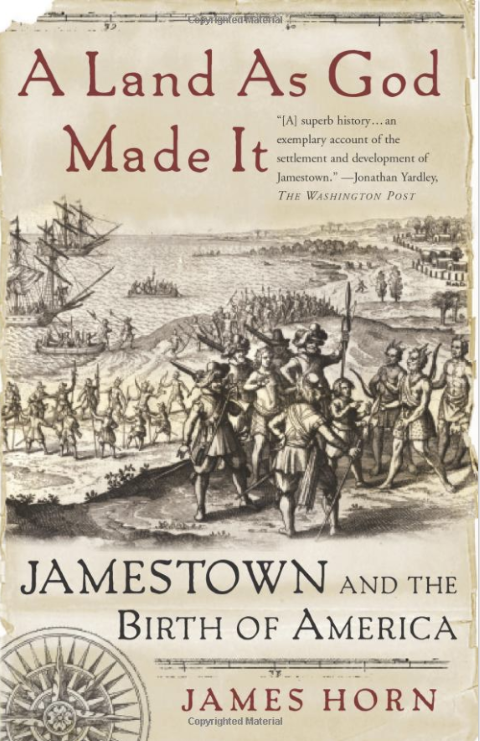
I just finished this excellent book by James Horn, A Land As God Made It: Jamestown and the Birth of America.
This book was in the show notes for the related episodes of the Podcast, “History of the Americans” by Jack Henneman. If you don’t listen to this podcast and you’re reading this blog, I’d highly recommend you start. I would be caught up with the most recent episodes were it not for the really good books he cites in the course of narrating the history of North America. This book is one of them.
As the subtitle suggests, this book tells the story of the arrival of the English on the shores of Chesapeake Bay and their attempts to set up a self-sufficient and profitable community. It is full of many wonderful anecdotes, surprises, and characters. It impresses the reader with the realities and hardships of the undertaking, and the incredible experiences of the Powhatan Confederacy. The story of one of the Confederacy’s chiefs leading up to the massacre of 1622 still blows my mind to contemplate (which I won’t give away here).
James Horn remarks in his epilogue that many Americans are unaware of the influence Jamestown had on the North American continent. People tend to associate the “founding” with turkey and pilgrims. He explains an interesting contrast between these two colonial efforts: Jamestown, at times to its detriment spawned and initiated by the visions and efforts of the landed gentry; and Plymouth, settled by religious exciles of meager means. That the story of Plymouth eclipsed Jamestown for many years as the founding myth of America is likely due in part to the outcome of the Civil War. The North won, and their founding myth took precedence in education to the exclusion of the story of Jamestown. These two settlements cast long shadows over the character of their respective regions of New England and the Southeast.
Regardless, this period of time has been a point of fascination for me lately. Nearly two centuries would pass before the U.S. Revolutionary War with England. I don’t remember learning much about this earlier timeframe in school or didn’t retain much information at the very least. These are the earliest European observations of the indigenous populations. This is a period of ascendency for a nascent British Empire. It is a time when a new Atlantic world is developed in the jostling between the British, the French, the Spanish, the United Provences, Morrocco, the Turks, and the kingdoms and empires of the indigenous Americans. Flintlock muskets are on the horizon, but guns are changing the cultures, economies, and capabilities of the varied indigenous tribes (I must take a moment to plug the excellent book attending to the same century, Thundersticks: Firearms and the Violent Transformation of Native America by David J. Silverman). The history of this period is an enchanting realm to explore.
Highly recommended! I found this book to be very readable and full of interesting information and insight.

